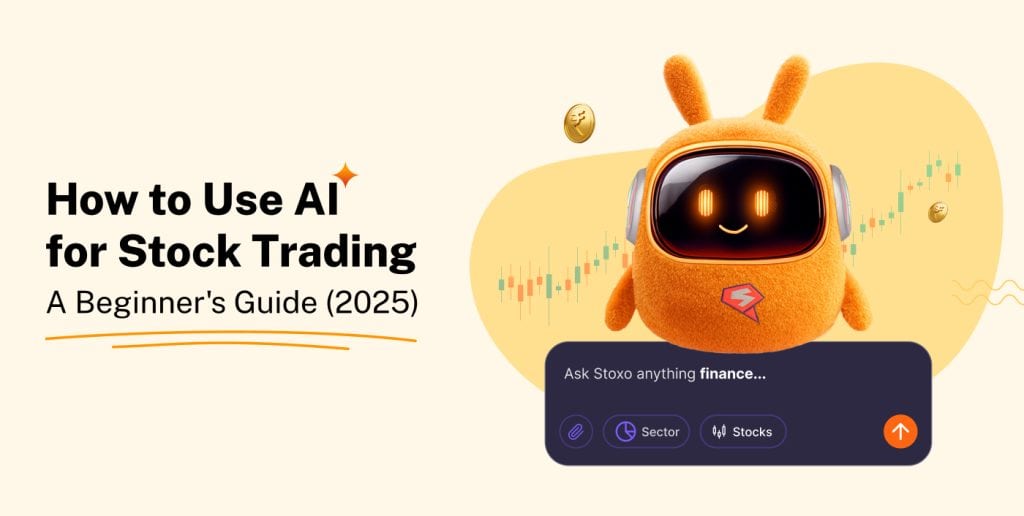
Want to know how to use AI for stock trading? This field grows faster than ever, with its value reaching $18.2 billion in 2023. Experts predict it could nearly triple by 2033. AI trading combines artificial intelligence, predictive analytics, and machine learning to analyze historical market and stock data.
AI stock trading tools analyze financial markets, calculate price changes, understand fluctuations, and execute trades automatically. These systems cut down research time, improve accuracy, predict patterns, and reduce overhead costs. A recent survey revealed that traders’ productivity improved by 10 percent through algorithmic trading.
The technology’s most important advantage lies in its ability to process and analyze massive data volumes to spot patterns and market inefficiencies. Your trading decisions become more logical as AI removes emotional biases from the process. Tools like Stoxo now make AI-powered insights accessible to more people, not just professional traders.
This piece shows you practical AI implementation in trading strategy. You’ll learn about the best tools for beginners and make smarter investment decisions with artificial intelligence.
Understanding AI in Stock Trading
AI has transformed the way stock markets work today. The core of AI trading includes several distinct approaches with their own benefits. Quantitative trading analyzes stock prices and volumes through mathematical models for major transactions. algorithmic trading utilizes machine learning to evaluate market trends before executing smaller trades.
High-frequency trading appeals to speed-focused traders by buying and selling large stock quantities within seconds, executing millions of trades instantly. Automated trading offers a simpler approach by following pre-programmed instructions based on straightforward strategies. Arbitrage trading takes advantage of price differences between markets.
The algorithmic trading market value reached $1307.90 billion in 2021 with a 12.2% yearly growth. AI-driven algorithms now handle 70% of all trading volume.
AI systems excel because they trade without emotional bias. These systems make decisions based on pure data, unlike human traders who often act on fear or greed. They work round the clock to monitor global markets.
Platforms like Stoxo help new traders use AI’s pattern recognition capabilities without technical knowledge. These tools can spot complex patterns that human traders often overlook, which helps investors make more informed decisions.
How to Use AI for Trading Effectively
AI trading success depends on a well-laid-out approach. The journey starts when you gather data collection – historical stock prices, technical indicators, news headlines, and sentiment data from social media.
Your next task involves cleaning and normalizing the collected data. This vital step will give a high-quality information feed to your AI model without errors or inconsistencies. Your model needs proper imputation techniques to handle missing data points that can substantially affect predictions.
Machine learning models need training with the preprocessed data. Neural networks, LSTM, and CNN work together to analyze patterns and predict future market movements. Research indicates CNN delivers better results than other models for stock price prediction.
Your strategy needs validation through backtesting. TradingView offers tools to simulate historical data trades in immediate conditions. These simulations help you fine-tune parameters and boost performance.
Market sentiment analysis could boost your prediction accuracy by 20%. Your AI system can process news articles, social media conversations, and financial reports to understand market sentiment.
Risk management should top your priority list. AI helps optimize position sizing and stop-loss levels. Stoxo makes this process easier by providing AI-powered insights without demanding technical knowledge.
Best AI Tools for Stock Market Beginners
Want to find the best AI tools to start your trading trip? Several powerful platforms analyze markets and spot opportunities much faster than humans can.
Tickeron’s Pattern Search Engine scans thousands of stocks each day. The tool analyzes 39 different pattern types and shows breakout prices, target prices, and confidence levels. Beginners will find it easy to use – they just need to select their criteria and pattern types, and the AI does the rest.
TrendSpider brings automated chart analysis that removes subjective interpretation. The platform detects chart patterns, trendlines, and Fibonacci levels with mathematical precision. Its multi-timeframe analysis lets traders view the complete picture across time horizons.
Danelfin ranks stocks on a 1-10 scale with AI and predicts which ones will beat the market in three months. Their data shows stocks with the highest AI Score (10/10) beat the market by +21.05% on average after three months.
Kavout’s Kai Score ranks stocks from 1-9 based on their potential and analyzes everything from fundamentals to market sentiment. Traders can ask questions in natural language with their InvestGPT feature.
Beginners can also check out Stoxo for an easy-to-use AI market analysis platform.
Conclusion
AI-powered stock trading marks a fundamental change in market approach strategies. You can now see how artificial intelligence removes emotional biases and processes massive amounts of data to spot opportunities humans might miss.
The process begins when you grasp different AI approaches like algorithmic and quantitative trading. You’ll then need to collect and clean data, train machine learning models, and completely test your strategies. This step-by-step method ensures your AI-based trading system has a strong foundation.
Beginners will find the right tools make all the difference. Platforms like Tickeron and TrendSpider give you powerful pattern recognition features without needing deep technical knowledge. Stoxo also gives everyday traders access to AI-powered market insights that were once limited to professionals.
AI trading will keep growing rapidly as we move toward 2025 and beyond. The time is right to add these technologies to your investment strategy. AI won’t guarantee profits, but it helps level the playing field between individual investors and large institutions. You can handle market challenges better and improve your trading results by combining AI tools with solid financial knowledge.
Key Takeaways
AI trading is transforming stock markets by eliminating emotional biases and processing vast amounts of data to identify patterns humans might miss, with the market valued at $18.2 billion in 2023.
• Start with quality data collection and cleaning before training AI models – missing or poor data significantly distorts predictions and trading outcomes.
• Backtest your AI strategy thoroughly using historical data before going live to refine parameters and validate performance in real market conditions.
• Beginner-friendly platforms like Tickeron, TrendSpider, and Stoxo make AI trading accessible without requiring deep technical expertise or programming skills.
• Incorporate sentiment analysis from news and social media – it can boost prediction accuracy by up to 20% compared to price data alone.
• Focus on risk management by using AI to optimize position sizing and stop-loss levels rather than chasing guaranteed profits.
AI trading levels the playing field between individual investors and institutions, but success still requires combining these powerful tools with solid financial knowledge and disciplined execution.
FAQs
AI enhances stock trading by analyzing vast amounts of data, identifying patterns, and making emotion-free decisions. It can process market information faster than humans, potentially leading to more accurate predictions and better-informed trading decisions.
Some popular AI tools for beginners include Tickeron for pattern recognition, TrendSpider for automated chart analysis, Danelfin for AI-based stock ranking, and Kavout for its Kai Score system. These tools offer user-friendly interfaces and powerful AI-driven insights.
While AI trading can provide valuable insights and potentially improve trading outcomes, it doesn’t guarantee profits. Success in trading still requires sound financial knowledge, disciplined execution, and effective risk management strategies.
To get started with AI trading, begin by collecting and cleaning historical market data. Then, use AI tools to analyze patterns and trends, backtest your strategies, and gradually implement them in live trading. It’s important to start small and continuously learn and adjust your approach.
The main advantages of using AI in stock trading include faster data processing, elimination of emotional biases, continuous market monitoring, improved pattern recognition, and the ability to analyze multiple data sources simultaneously. This can lead to more efficient and potentially more profitable trading strategies.

Leave a Comment